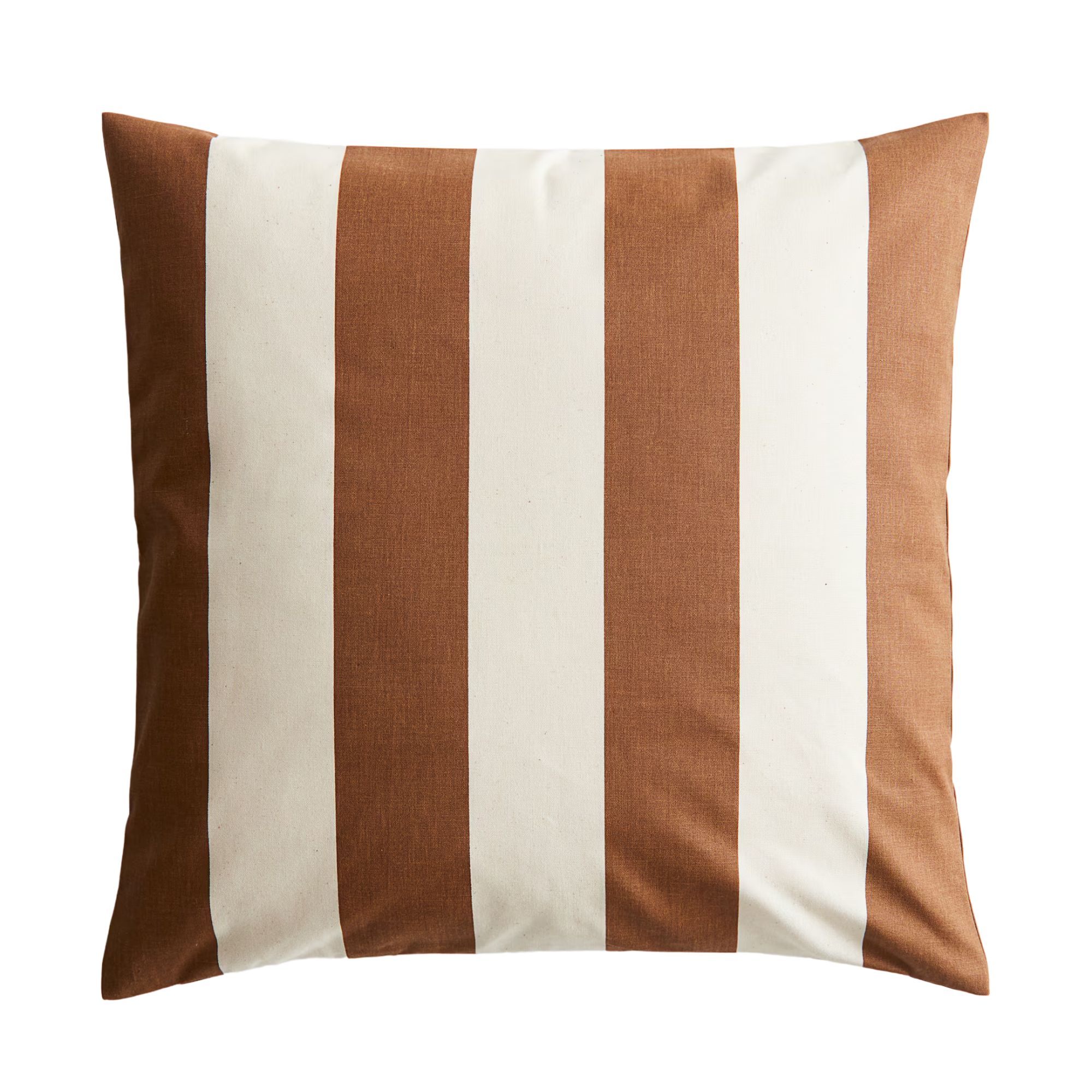11 Outdoor Living Room Ideas That Blur the Line Between Inside and Out
There are so many ways to curate an outdoor living area that begs you to come and sit for a while... but these are the designer's favorites


As an Australian, having an outdoor living space to soak up the sunshine in is one of life's necessities. But when it comes to outdoor living room ideas, people too often think it's as simple as buying a matching furniture set and calling it a day.
And while, yes, having the best garden furniture can make or break your space, it's not the only way to curate a 'room' that you actually want to spend time in; one that looks and feels as good as your interiors.
So, below, I've shared ten outdoor living room ideas that will inspire you to think outside the, well... house. Whether that's hooking up a garden swing, making a focal point of a fire pit, or treating lighting just as intensely as you would inside, here's how to do it.
1. Don't Go Straight to a Sofa
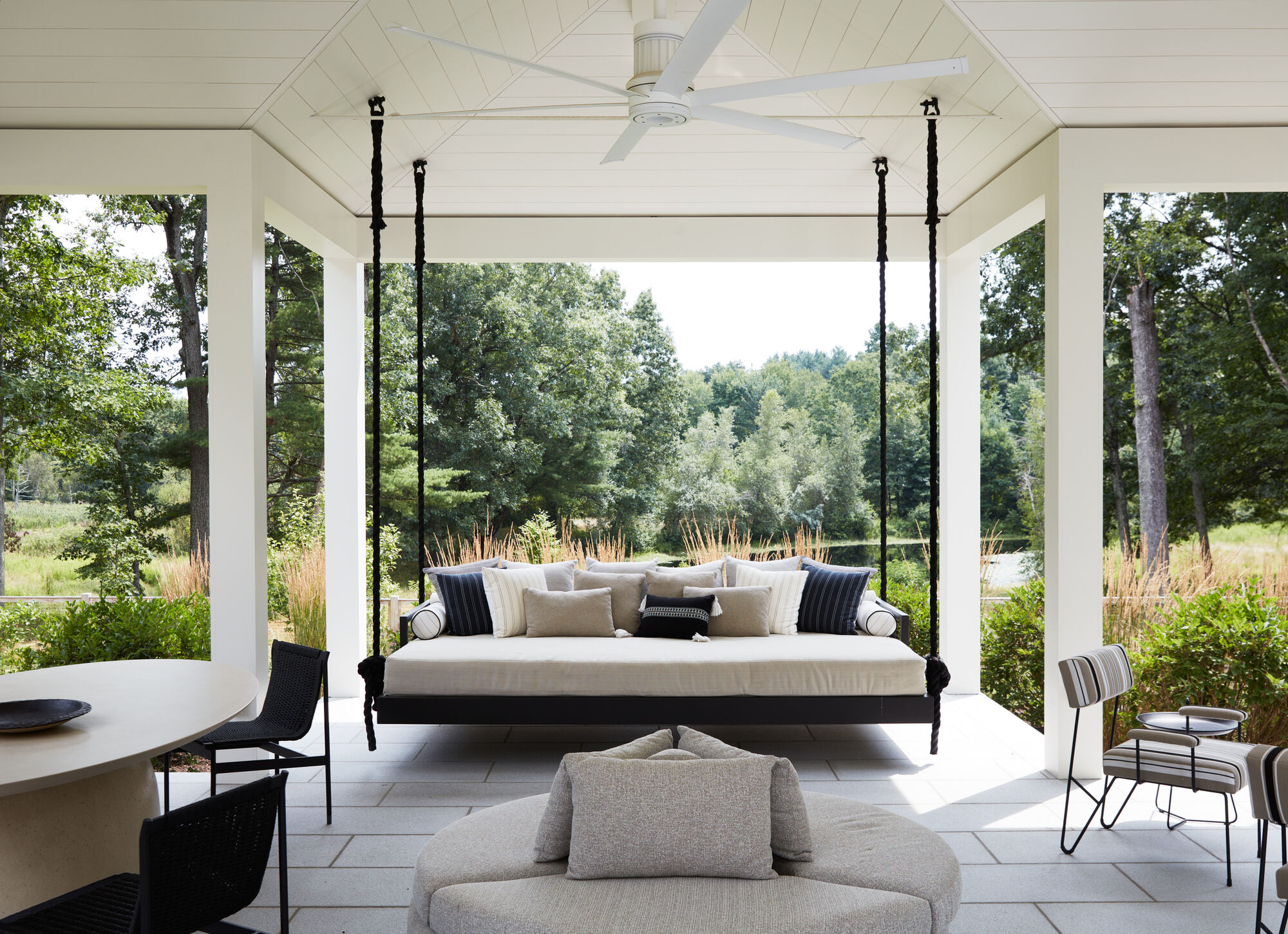
Swings aren't only for children. They're an easy way to make any outdoor living room ideas feel instantly more inviting.
When it comes to picking furniture for your outdoor living room, you shouldn't always automatically opt for a sofa. Susana Simonpietri, creative director of Chango, instead made a garden swing chair the focal point of the outdoor living room shown above.
Not only does it draw attention, but the black cord detailing also complements the home's exterior, she says.
"The swing really helps to tie together the various other seating and dining areas we created on this patio," Susana continues. "It's a great piece to incorporate in a larger space, and it's always the children's favorite spot to curl up after a dinner al fresco."
2. Create a Conversational Setup With Armchairs
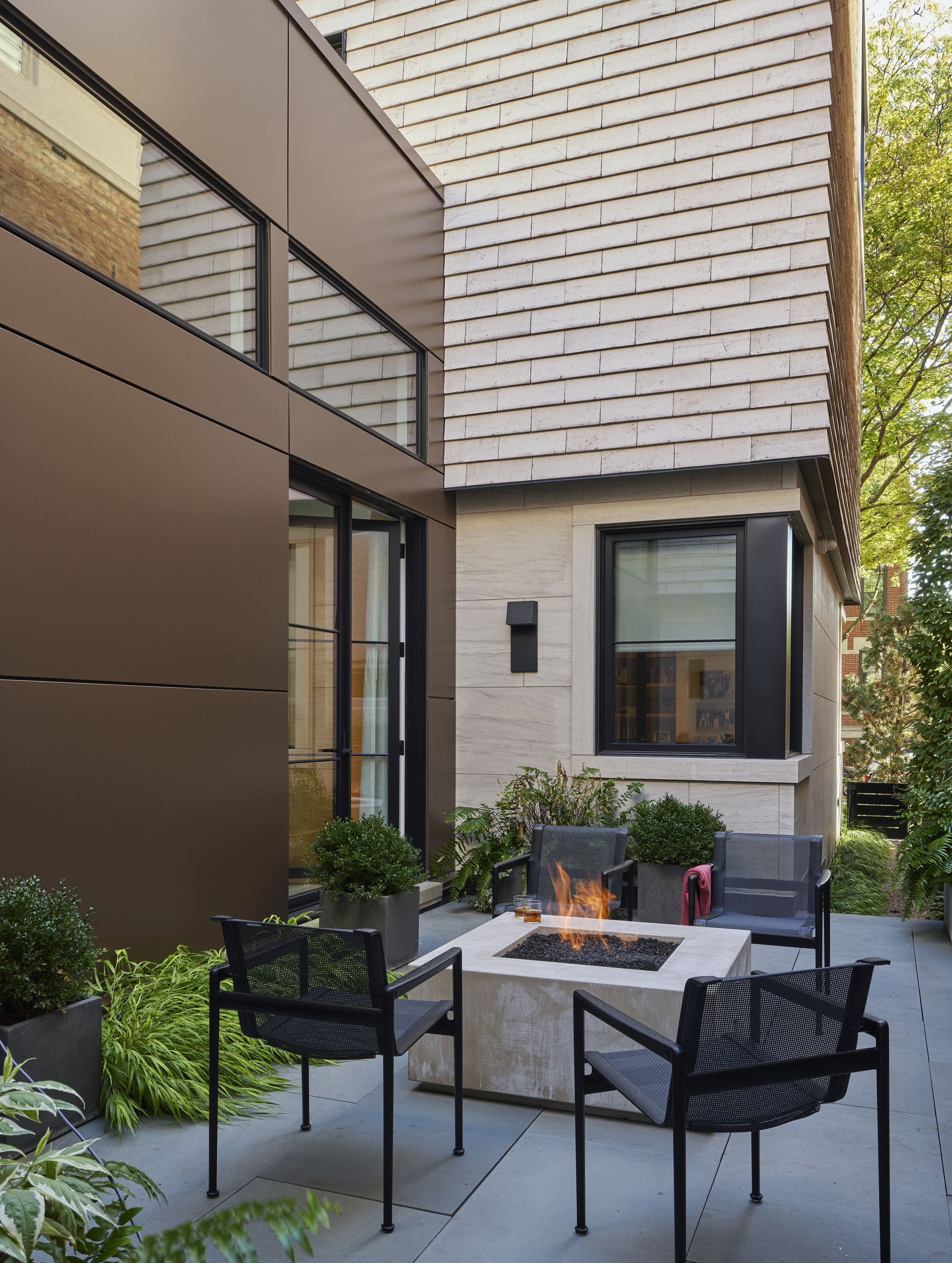
Opting for armchairs rather than one large sofa can help curate a more conversational outdoor living room setup.
"So many people default to outdoor sofas, but in this case, we intentionally chose armchairs to create a more open, conversational layout," explains interior designer Amy Kartheiser. "Unlike a sofa, which can feel directional or limit movement, armchairs allow each guest to have their own defined space while still feeling connected to the group."
The Livingetc newsletters are your inside source for what’s shaping interiors now - and what’s next. Discover trend forecasts, smart style ideas, and curated shopping inspiration that brings design to life. Subscribe today and stay ahead of the curve.
It also redirects the focus of the outdoor living room elsewhere — and in this case, to the firepit. "The arrangement around it encourages conversation and lingering," adds Amy.
"There's also something timeless and grounding about the symmetry of four chairs — it's structured, but still relaxed," she adds. "Ultimately, I think this outdoor living room idea feels so inviting because it doesn’t try too hard. It invites you to sit down, put your feet up, and stay awhile."
3. Consider the Indoor-Outdoor Connection

Just as you would inside, consider how the soft furnishings you choose for your outdoor living room ideas complement your style.
The best way to create an outdoor living room that feels like a room rather than just outside is to think about indoor-outdoor living and how you can make the space feel the same as the spaces inside your home.
One easy way: soft textiles. "My advice is to select pieces that vibe well with whatever style pieces you have indoors," says landscape designer Kat Aul Cervoni, founder of Staghorn NYC and popular blog, The Cultivation. "That way, your outdoor space will feel like a true extension of your home."
Think about rugs, cushions, blankets... but, of course, you'll still need to factor the added practicality required, too. "If you’d prefer to keep your furniture cushion free, but still want to up the comfy factor, add a cluster of pillows with outdoor-grade fabric," says Kat. "Always invest in furniture covers to help with longevity and, if possible, store your upholstered items somewhere waterproof for the winter."

Katherine "Kat" Aul Cervoni is the founder of Staghorn, a company devoted to sustainable planting. She's always had a strong passion for outdoor living, and aims to create spaces that feel like natural extensions of a home's interior.
4. Get the Layout Right
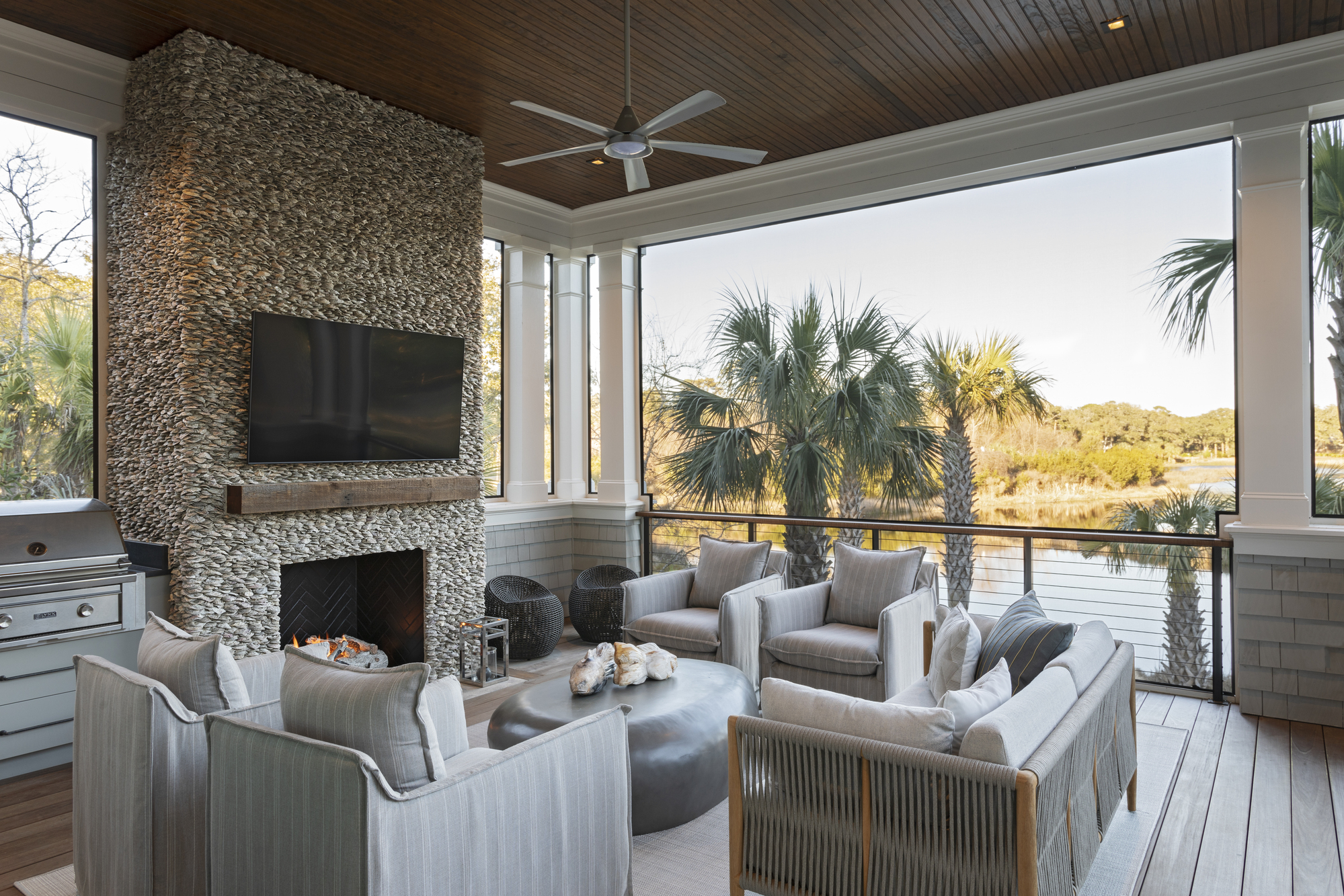
As with anywhere else in the home, getting the layout right in your outdoor living room is crucial.
One of the key aspects to consider in your outdoor living room ideas, as when designing a space inside, is getting the right layout — this is crucial. For interior designer Jake Arnold, it's all about invoking conversation and movement amongst your guests.
"Ideally, you'd have two sofas or four chairs facing each other, with space between everything so it feels really opened up," he told Livingetc recently.
Of course, the best layout depends on your space; an ideal outdoor furniture layout for a small patio will differ from that of a larger space that requires zoning to make it more cozy and intimate.
Whatever the size of space you have, the general rule of thumb is to think about how you intend to use it, the furniture that will help facilitate that, and how it will best fit in your outdoor living area.

Jake Arnold is a renowned Los Angeles-based interior designer who has become known for his impactful yet liveable style. He recently collaborated with Crate & Barrel to design an outdoor furniture range, so he knows more than a thing or two when it comes to curating the best outdoor living room ideas.
5. Consider Your Furniture Choices Carefully

Even more than just aesthetics, your choice of furniture for your outdoor living room can impact its entire vibe.
Believe it or not, the specific furniture you pick for your space can have a huge influence over how comfortable your outdoor living room is.
"You don't want materials that are too delicate — it should all look robust enough that it can be perched upon," Jake Arnold says, adding that, "Sofas should be deep, which encourages you to lounge a bit more... to chill."
In terms of the best materials to go for, he recommends wicker, rattan, and limestone, not only for their innate sense of style, but the fact that they feel substantial, rather than flimsy. Similarly, if you're going for wood furniture, it's worth reading up on the best wood for outdoor furniture to ensure it will last for seasons to come.
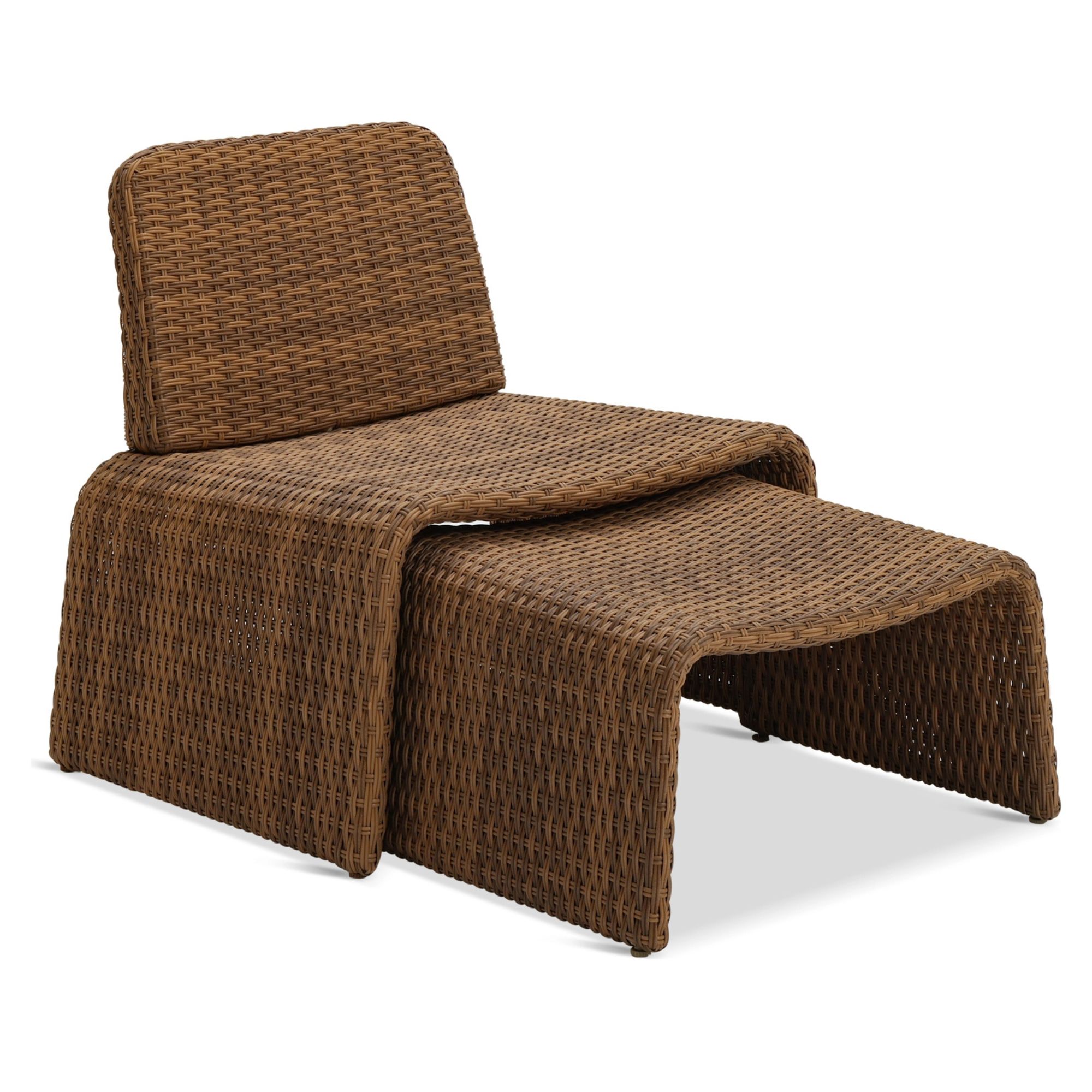
You want your furniture to say 'come and sit for a while,' and this extendable rattan-effect garden chair is basically begging me to recline. With a curving seat, smooth edges, and steel frame, it's sturdy and stylish.
6. Keep it Cohesive With a Specific Style
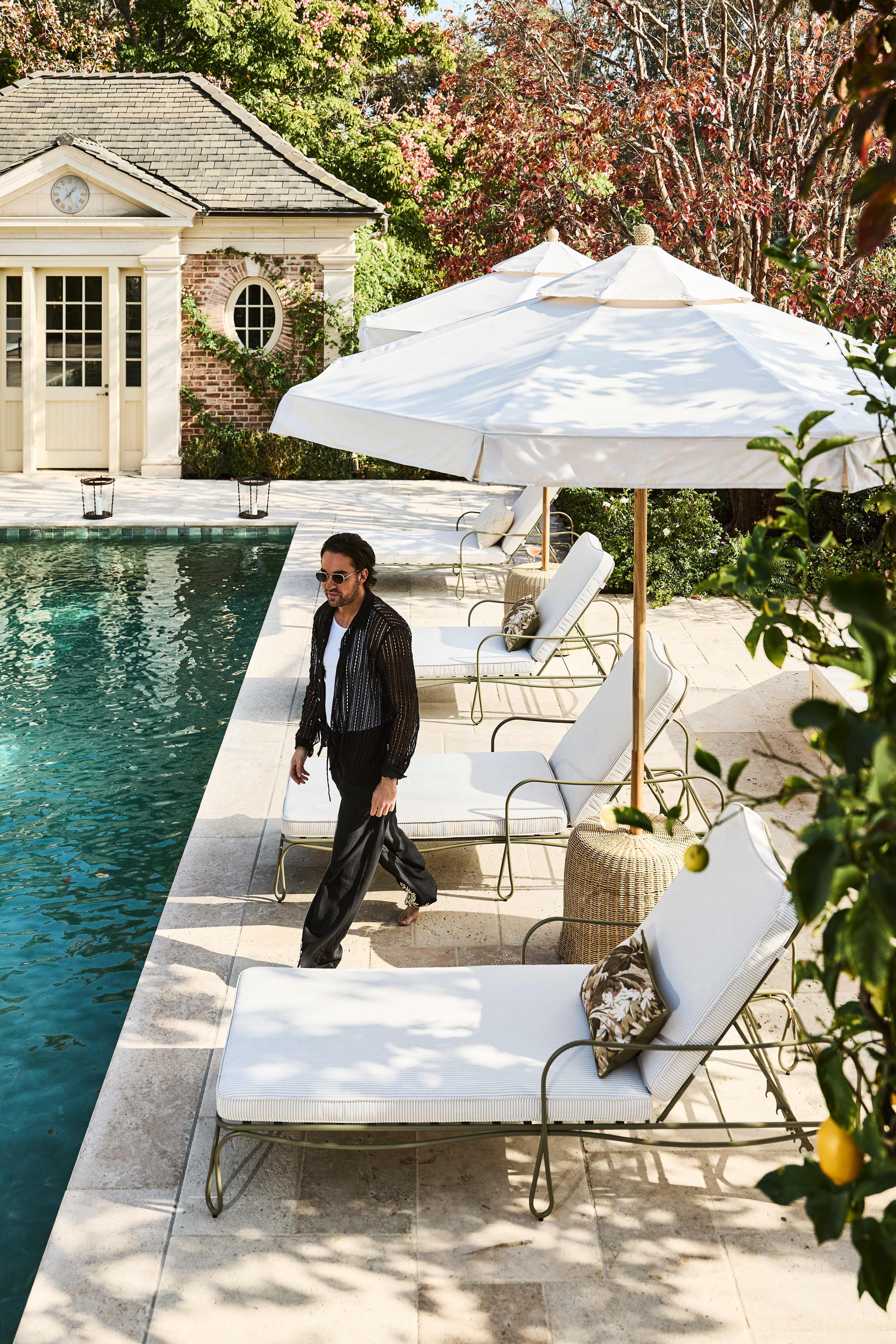
'Outdoor' isn't a style, so don't fall into the trap of setting your aesthetic aside just because you're outside.
Just like you would inside, don't skip the step where you decide on a specific style for your outdoor living room ideas. (Remember: 'outdoor' isn't really an aesthetic in itself.)
For his recent outdoor furniture collection with Crate & Barrel, Jake Arnold leant into a Hollywood Regency aesthetic with curves, tassels, and latticed edges.
"I think that period is a good reference for anyone's outdoor space, as it's wrapped in the notion of escapism, of films you might have seen as a child or holidays you've been on," he says.
7. Create a Focal Point with a Firepit

A fire pit is a great way to create a focal point for your outdoor living room, encouraging people to gather.
There is something about the flicker of flames in a stylish fire pit that beckons people to come and sit for a while — perfect for an outdoor living room idea, if you ask me.
What's more, a fire pit in your outdoor living room will extend your usage of the space well into the cooler months. And it provides a focal point for you to style your furniture around.
And if cost is a concern, "For a less expensive and more flexible option, I recommend a metal design such as the Solo Stove or a metal fire bowl," says Kat. "Arrange comfy outdoor lounge chairs, such as Adirondacks, around your fire pit for a cozy evening with friends or family."
This Solo Stove Portable Fire Pit from Amazon gets a glowing 4.7/5 stars after almost 900 reviews.
8. Introduce a Layered Lighting Scheme

Lighting can make or break even the best outdoor living room ideas, so make sure yours is ready at the flick of a switch.
The smallest detail that can make the biggest difference to your outdoor living room ideas? Lighting. There's nothing that kills the vibe faster than a harsh overhead light (or losing light altogether), so you'll want to make sure you curate a layered patio lighting scheme for your outdoor living space.
"Not only does it add an inviting, warm glow to your space, but it also extends your garden or patio’s usability beyond daylight hours," adds Kat.
Some popular options include outdoor uplighters, table lanterns, and there are even rechargeable outdoor pendant lights you can buy these days, to give your outdoor living room the same feeling as your interiors.
"Low-voltage uplights nested amidst plantings give a beautiful, glowy feel to your space that can be enjoyed from indoors and outdoors," says Kat. "I like shining them up into trees to give some dimension as well as ornamental grasses for a gorgeous shadow effect."
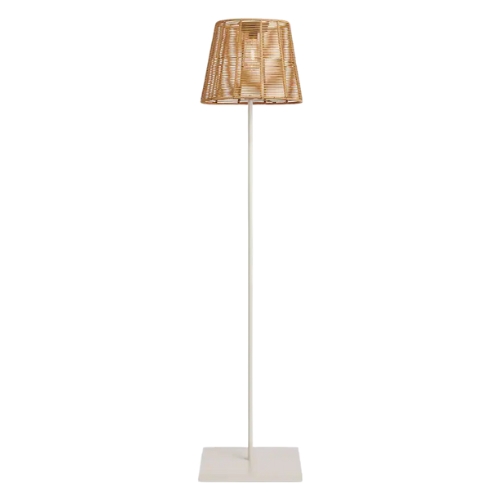
And don't forget that solar outdoor floor lamps are a thing now, too. This classic style will complement any outdoor seating, while the 8-10 hour run time ensures you can keep hosting long after the sun has set.
9. Ensure Privacy With a Garden Screen

A privacy screen can help turn an exposed outdoor living room into a secluded space you actually want to hang out in.
It can be hard to really relax in the garden, knowing your nosy neighbors might be able to see you. That's why your garden screening ideas are one of the most important aspects to consider in your outdoor living room ideas, to ensure that your space feels personal, private, and secluded.
"A custom or prefabricated privacy screen can be just the ticket for blocking unwanted views into your space," says Kat. "A wooden skinny slat style adds some warmth and a contemporary flair, while metal mesh or panels give a sleeker, more modern vibe and are great for spaces short on square footage."
But privacy screens can also do more than just provide privacy — they can help zone a larger outdoor living room, as well as create an aesthetic feature in the space, depending on the style you choose.
For a more natural approach, you could even try a 'green' screen alternative, with vertical gardens, hedges, or with some of the best plants to cover a fence quickly.
"Evergreen shrubs or hedges are a classic choice, and you can choose from boxwood, yew, laurel, or juniper depending on the amount of space you have, sun conditions, and how much height you need," says Kat. "Fastigiate hornbeams are another personal favorite, although they're not evergreen."

Perfect for zoning a large garden or for adding a decorative layer to your intimate retreat, this outdoor privacy screen also works beautifully as a trellis. Crafted from solid steel with protective paint, it will stand up to the elements, protected against rust and water damage, all while adding style to your outdoor living room.
10. Curate the Feeling of a 'Room' With a Cover

Sometimes the simplest way to make your outdoor area feel more like a room is to put a ceiling on it.
Another way to make outdoor living room ideas feel like a room, rather than the outdoors, is by providing some kind of cover — be that a simple shade cloth, or more permanent structure.
"It's the perfect way to create an indoor-outdoor space which feels like it naturally flows into your home," says Chloe Burrows, an interiors expert at Laura James, who adds that, "If you have decking or a tiled area by your back door, this is the ideal for an extended-living-room-effect."
11. Put Up a Pergola
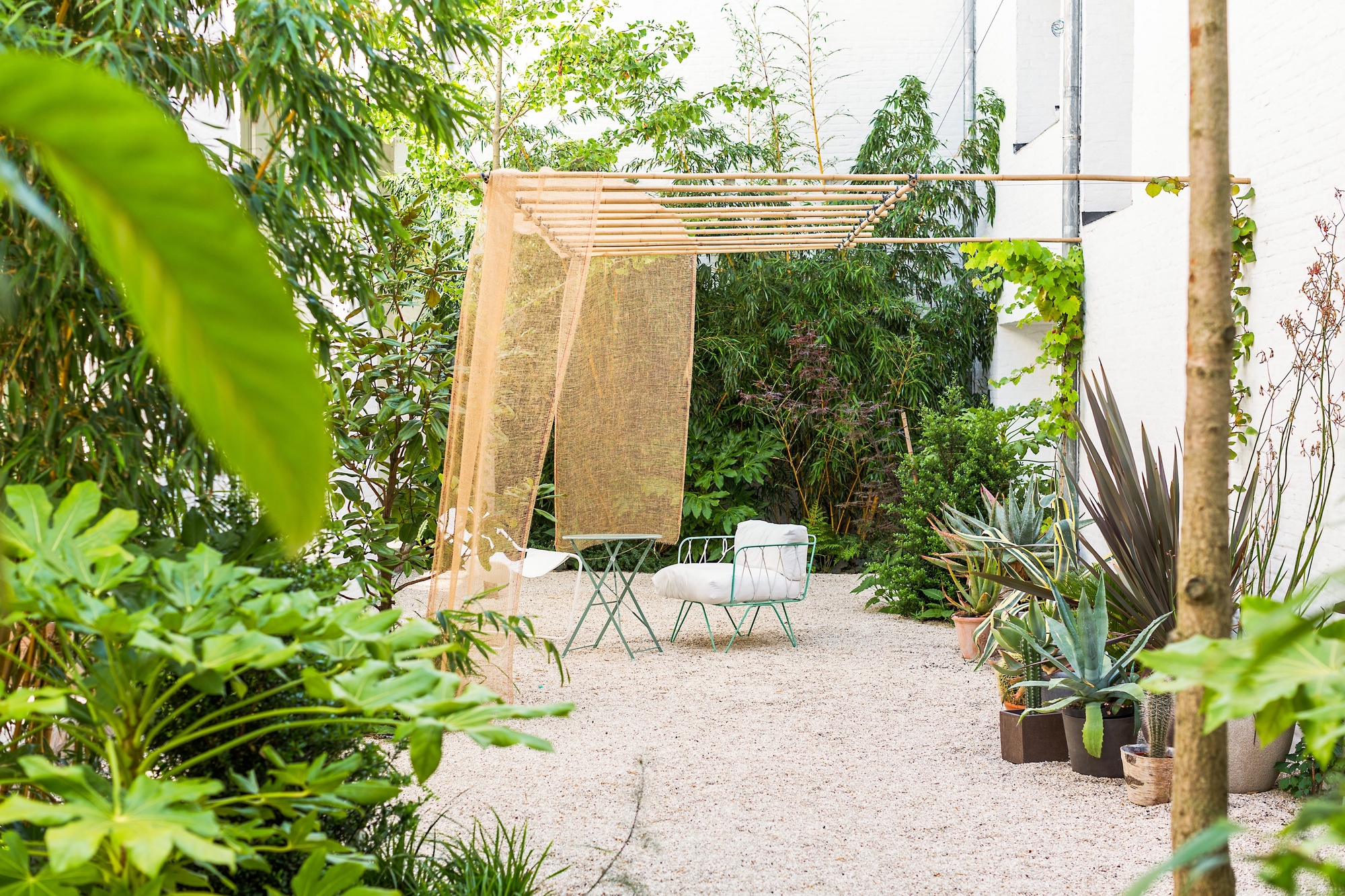
Pergolas are a great alternative, says Chloe. "You can layer it to give you the exact cover you’re looking for," she says. "On a sunny day, you might want to leave it bare. Other days, a sail attachment would be perfect to add to provide that extension-like feel, alongside cover and privacy.”
For something less permanent that lets you still feel part of nature, opt for a pergola.
"The most agreeable form of shadow is a natural one, so normally we prefer to sit in the shade of a tree," shares Belgium-based garden architects, Bart Haverkamp and Pieter Croes of Bart & Pieter (who have just released a book, Wild Harmony - Urban Gardens. But this isn't always possible, so the next best thing is finding less-intrusive pergola ideas.
"You can plant several climbers around it so it gets covered really quickly," they add. "It can also be used to hang things from — lighting, candles, but also fabrics or mats (like bamboo) — all of these items provide extra color and texture."
And this idea works for more than just providing shade. "It can become like a little outside ‘room’," the explain. "It makes the dimensions of a big place a little bit cozier by creating this small pleasant corner that shelters you in more than one way."
Ultimately, the best way to ensure your outdoor living room ideas contribute to a space you'll actually use is to treat it as you would any other space inside your home.
Stick to your style, pick pieces that feel inviting, and steer clear of any tacky outdoor furniture mistakes.
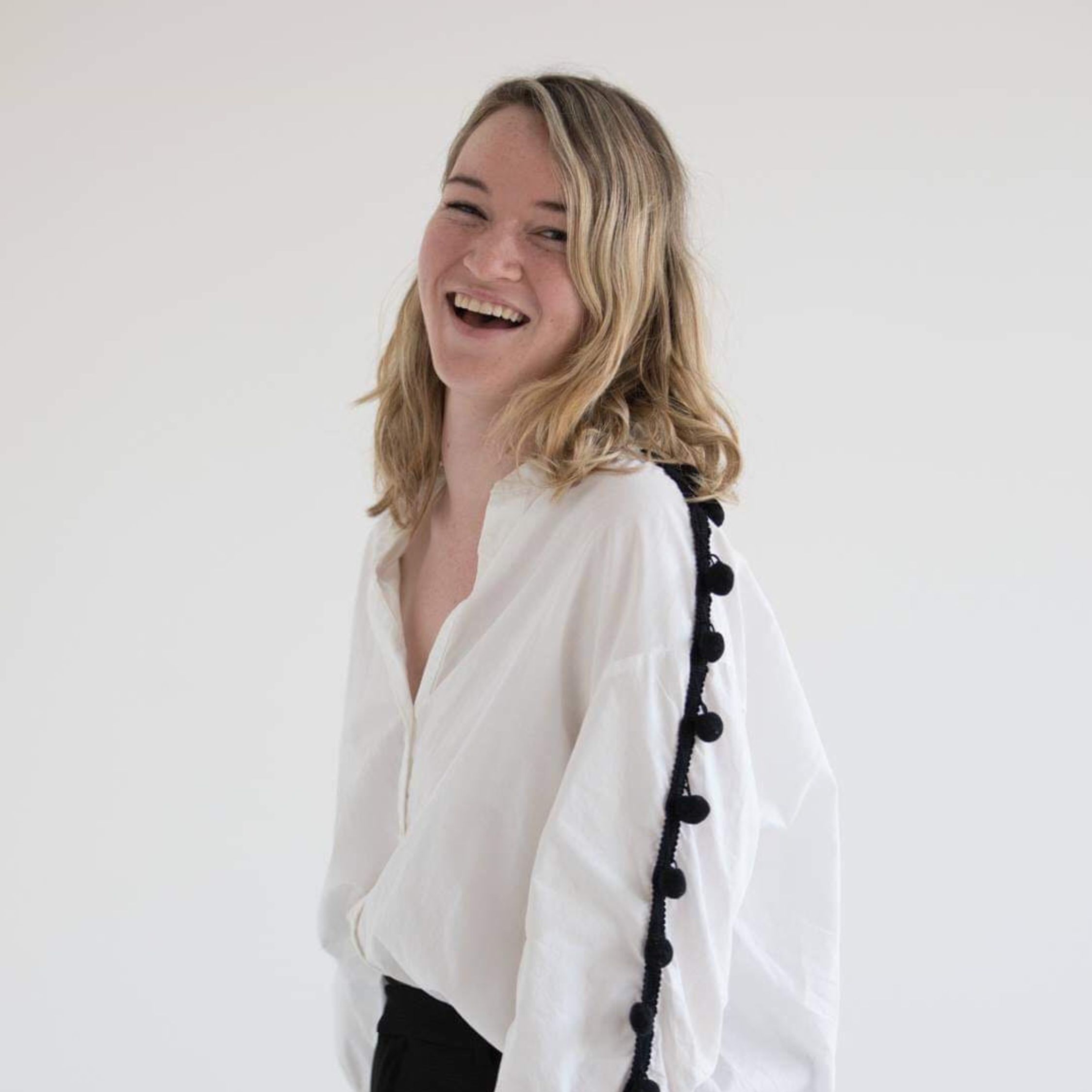
Emma is the Interiors Editor at Livingetc. She formerly worked on Homes To Love, one of Australia's leading interiors websites, where she wrote for some of the country's top publications including Australian House & Garden and Belle magazine. Before that she was the Content Producer for luxury linen brand, CULTIVER, where she nurtured a true appreciation for filling your home with high-quality and beautiful things. At Livingetc, she spends her days digging into the big design questions — from styling ideas to color palettes, interior trends and home tours. Outside of work hours, Emma can often be found elbow-deep at an antique store, moving her sofa for the 70th time or mentally renovating every room she walks into. Having just moved to London, she's currently starting from scratch when it comes to styling her home, which, while to many may sound daunting, to her, is just an excuse to switch up her style.
